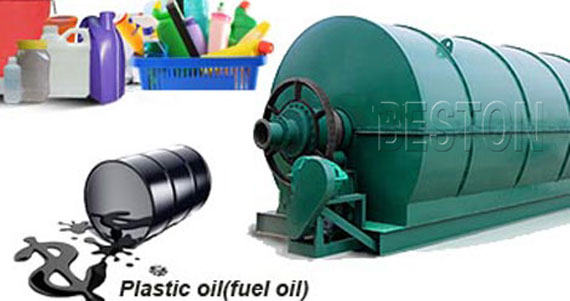Recycling waste plastics can not only reduce waste emissions, but also save resource of energy. Plastic is from oil, so recycling waste plastic can reduce oil consumption.
Because waste plastic, such as polyethylene, polypropylene, polystyrene, etc., is extracted from oil through a series of processes. For example, polyethylene plastic is synthesized with ethylene, while ethylene is generated from the pyrolysis of various petroleum hydrocarbon raw materials, such as petroleum, light diesel oil, etc. In turn, we can obtain gasoline, diesel, liquefied gas and other useful components to dispose waste plastics by heating and catalytic.
The basic principle of thermal decomposition technology is to conduct thorough macromolecular chain decomposition in the original polymer resin of waste scrap plastic products and make it return to the state of low molar mass and thereby, to obtain the products with higher values. Different types of plastics have different thermal decomposition mechanism and final products. The thermal decomposition of PP, PE is mainly in the form of no-rules broken chain. There is almost no corresponding monomer in the thermal decomposition final products. Thermal decomposition is accompanied by depolymerization and random chain-breaking reaction, and the thermal decomposition final products have a part of styrene monomer.
Almost all types of plastics can be converted into fuel oil , gas by pyrolysis. But different types of plastics and different pyrolysis technologies make the oil yields different. By using catalytic pyrolysis technology, the oil yield can reach about 50% and there is a little gas; while by using thermal cracking technology, there are more gas generating and the oil yield only reaches less than 50%.
The most typical technology of waste plastic oilification is waste polyethylene oilification, which includes pyrolysis, catalytic pyrolysis (one step), pyrolysis-catalyzed upgrading (two steps).
1. The composition of final products generated by pyrolysis method is dispersed and has lower value. The oil from pyrolysis has higher wax content, higher pour point, lower cetane number and lower gasoline octane number.
2. Catalytic pyrolysis (one stpe) is conducted by pyrolysis and catalysis at the same time. The advantages are low pyrolysis temperature, short time required, high liquid yield, low investment, while the disadvantages are the large amount of catalyst used and it is difficult to separate carbon black and impurities.
3. Pyrolysis-catalyzed upgrading (two steps) refers to the pyrolysis of waste plastics and then conduct catalytic modification in pyrolysis end-products. Finally we get oil products. It has the widest applications and prospects for development, which has attracted attention both at home and abroad.


